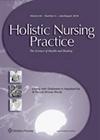John A Brennan, Ryan Brennan, Sue Bojka, Cheryl Green, Todd Lane, Cynthia Martins, Beth Williams, Andy Quito
求助PDF
{"title":"Impact of an Aromatherapy Program on Managing Surgical Patients' Perceived Nausea and Vomiting.","authors":"John A Brennan, Ryan Brennan, Sue Bojka, Cheryl Green, Todd Lane, Cynthia Martins, Beth Williams, Andy Quito","doi":"10.1097/HNP.0000000000000760","DOIUrl":null,"url":null,"abstract":"<p><p>Postoperative nausea and vomiting (PONV) is a major practice concern. It can cause adverse patient experiences and contribute to an increased length of stay. This is especially true among orthopedic surgery patients. This study utilized aromatherapy, a holistic intervention to better manage PONV. This study is a quality improvement project that used a pre- and post-intervention design to determine significance. Participants scored their perceived nausea and vomiting on a scale of 0 (no nausea) to10 (severe nausea) at intervals of 4 hours. The practice change utilized QueaseEASE©, an aromatherapy clip that is a blend of peppermint, lavender, spearmint, and ginger. This product was attached to orthopedic surgical patient's gowns during the intervention phase of the project. The infusion clips provided continuous aromatherapy for the entirety of a postoperative course and were used in addition to the standard of care. Data were collected by clinical staff at the specified intervals. Information from the preintervention and postintervention groups were compared to determine the impact on perceived PONV. A total of 290 participants provided data during the practice change. A Chi-square test showed a value of (P = .035) and a Wilcoxon sign-rank test of (P = .058). Evidence-based literature supports the utilization of an aromatherapy intervention for the management of PONV. There was a significant decrease in instances of perceived PONV amongst compared groups. Despite a decrease in nausea severity, there was no significance determined in this measure. Aromatherapy is a valid tool to mitigate the impact of perceived PONV.</p>","PeriodicalId":13081,"journal":{"name":"Holistic Nursing Practice","volume":" ","pages":""},"PeriodicalIF":1.6000,"publicationDate":"2025-09-19","publicationTypes":"Journal Article","fieldsOfStudy":null,"isOpenAccess":false,"openAccessPdf":"","citationCount":"0","resultStr":null,"platform":"Semanticscholar","paperid":null,"PeriodicalName":"Holistic Nursing Practice","FirstCategoryId":"3","ListUrlMain":"https://doi.org/10.1097/HNP.0000000000000760","RegionNum":4,"RegionCategory":"医学","ArticlePicture":[],"TitleCN":null,"AbstractTextCN":null,"PMCID":null,"EPubDate":"","PubModel":"","JCR":"Q3","JCRName":"INTEGRATIVE & COMPLEMENTARY MEDICINE","Score":null,"Total":0}
引用次数: 0
引用
批量引用
Abstract
Postoperative nausea and vomiting (PONV) is a major practice concern. It can cause adverse patient experiences and contribute to an increased length of stay. This is especially true among orthopedic surgery patients. This study utilized aromatherapy, a holistic intervention to better manage PONV. This study is a quality improvement project that used a pre- and post-intervention design to determine significance. Participants scored their perceived nausea and vomiting on a scale of 0 (no nausea) to10 (severe nausea) at intervals of 4 hours. The practice change utilized QueaseEASE©, an aromatherapy clip that is a blend of peppermint, lavender, spearmint, and ginger. This product was attached to orthopedic surgical patient's gowns during the intervention phase of the project. The infusion clips provided continuous aromatherapy for the entirety of a postoperative course and were used in addition to the standard of care. Data were collected by clinical staff at the specified intervals. Information from the preintervention and postintervention groups were compared to determine the impact on perceived PONV. A total of 290 participants provided data during the practice change. A Chi-square test showed a value of (P = .035) and a Wilcoxon sign-rank test of (P = .058). Evidence-based literature supports the utilization of an aromatherapy intervention for the management of PONV. There was a significant decrease in instances of perceived PONV amongst compared groups. Despite a decrease in nausea severity, there was no significance determined in this measure. Aromatherapy is a valid tool to mitigate the impact of perceived PONV.
芳香疗法对外科病人恶心和呕吐的影响。
术后恶心和呕吐(PONV)是一个主要的实践问题。它可能导致不良的患者经历,并有助于增加住院时间。在整形外科患者中尤其如此。本研究利用芳香疗法,一种整体干预,以更好地管理PONV。本研究是一个质量改善项目,采用干预前和干预后设计来确定显著性。参与者以0(无恶心)到10(严重恶心)的范围对他们的恶心和呕吐进行评分,间隔4小时。实践改变使用了QueaseEASE©,这是一种混合了薄荷、薰衣草、绿薄荷和姜的芳香疗法夹。本产品在项目干预阶段附在骨科手术患者的手术服上。输液夹在整个术后过程中提供持续的芳香疗法,并在标准护理之外使用。临床工作人员每隔一段时间收集数据。比较干预前组和干预后组的信息,以确定对感知PONV的影响。共有290名参与者在实践变化期间提供了数据。卡方检验的值为(P = 0.035), Wilcoxon符号秩检验的值为(P = 0.058)。循证文献支持芳香疗法干预治疗PONV的应用。在对照组中,感知到PONV的情况显著减少。尽管恶心严重程度有所降低,但在这项测量中没有确定显著性。芳香疗法是减轻感知PONV影响的有效工具。
本文章由计算机程序翻译,如有差异,请以英文原文为准。

 求助内容:
求助内容: 应助结果提醒方式:
应助结果提醒方式:


